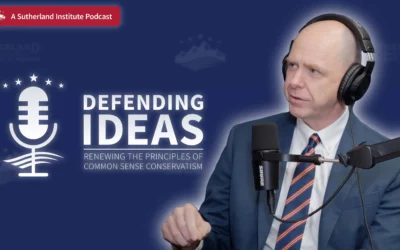
Written by Christine Cooke Fairbanks
June 13, 2024

The Utah Legislature’s recent Joint Resolution Concerning the Success Sequence directly encouraged two actions: (1) the Utah State Board of Education to review the state academic standards and (2) local education agencies to review instructional and curricular materials – both as a way to identify opportunities to incorporate instruction into grades 6-12 about the outcomes of completing the milestones in the “success sequence.”
The success sequence says 97% of individuals avoid poverty if they: (1) graduate from high school, (2) get a full-time job, and (3) marry before having children. Because the sequence has three planks, instruction in the outcomes of following the success sequence might fit into many academic standards and curricular options. There may also be opportunities to modify standards or create curriculum to meet these needs.
To help this effort, we are reviewing the Utah Academic Standards and curriculum to find opportunities to bring this invaluable information to students in their prime decision-making years.
Below are existing standards that secondary education teachers might be able to use to teach the success sequence outcomes as well as some recommendations to current standards to bolster educators’ ability to bring the sequence to the classroom.
Health Standards
The Utah Core Standards for Health Education have several strands and standards for secondary students that discuss relationships, sexual abstinence, pregnancy, parenting, and responsibilities within families, all of which can help students understand better their choice of when to have children – before or after marriage. See below for secondary education standards that could most naturally prompt discussion about the success sequence.
Health I
Strand 6 – Human Development
Standard HI. HD.3: Define and describe the mental, emotional, physical, and social benefits of practicing sexual abstinence.
Standard HI.HD.4: Understand the process of pregnancy, practices for a healthy pregnancy, and pregnancy prevention.
Standard HI.HD.8: Recognize characteristics of healthy and unhealthy relationships.
Health II
Strand 6 – Human Development
Standard HII.HD.2: Define and describe the mental, emotional, physical, and social health benefits of sexual abstinence.
Standard HII.HD.3: Explain the process of conception, fetal development and birth, practices for a healthy pregnancy, pregnancy prevention, and parenting responsibilities.
Standard HII.HD.8: Recognize characteristics of healthy relationships, the impact a relationship has on wellness, practice skills to build healthy relationships, and emphasize the responsibility within families and communities to support healthy relationships.
Two standards use the same text prompting students to describe the multiple benefits of sexual abstinence. We recommend that the language include “financial” or “economic” benefits as part of the standard in order to discuss the success sequence.
Other health standards discuss childbearing – starting with how to recognize healthy or unhealthy relationships – the process of pregnancy, and parenting responsibilities. All these topics can equip students to better understand how their choices impact family formation and how family formation impacts them. Furthermore, there is research suggesting a link between living the success sequence and mental and physical health outcomes. We recommend adding a strand or standard that covers such connections.
General Financial Literacy
Before graduation, Utah students are required to take a general financial literacy course. Several of the strands and standards for the course, which is taken by juniors or seniors, can be used to incorporate the success sequence.
General Financial Literacy
Strand 1: Students will understand basic economic concepts and develop economic thinking critical to making personal financial choices.
Standard 1: Understand how basic economic principles affect personal financial choices.
-
-
- Apply economic reasoning skill to make informed personal financial decisions including opportunity costs (tradeoffs) and their role in decision-making.
-
Strand 2: Students will understand the factors that influence personal financial priorities and learn how to make rational decisions.
Standard 1: Analyze the role of emotional, cultural, and social influences on financial behavior.
-
-
- Evaluate the role of emotions, attitudes and habits in making financial decisions.
- Understand how culture and values influence financial decisions and goals.
-
Standard 2: Define a rational decision-making process.
-
-
- Recognize that individuals are responsible for their own financial decisions and for subsequent positive and negative consequences.
- Describe cost-benefit analysis as a rational decision-making process.
- Compare instant satisfaction with delated gratification, such as impulse buying versus planned expenditures.
-
Strand 3: Students will understand sources of income and the relationship between career preparation and lifetime earning power.
Standard 1: Identify sources of income and specific employability skills.
-
-
- Evaluate and compare career opportunities based on individual interests, skills and educational requirements, the value of work to the market, and income potential.
-
Standard 2: Understand and begin preparation for post-secondary training and career.
-
-
- Recognize and explore the correlation between education, training, and potential lifetime income.
- Identify components to be included on a resume and/or electronic professional profile, such as appropriate contact information, experience [educational, work, and volunteer], skills, certificates obtained, accomplishments, interests, and references.
- Identify sources and strategies for finding employment, as well as the benefits of networking
- Identify soft skills [communication, teamwork, time management, problem-solving, punctuality] that increase employability, retention, and earning power.
-
Some standards naturally prompt discussion of the success sequence through topics like understanding opportunity costs in decisions like choosing to complete school over other activities. Another standard discusses how a range of factors (including cultural) impact our financial choices; this could include cultural ideas about education and employment.
Other strands and standards directly discuss career opportunities and required education programs to enter these careers. Such topics may allow educators to discuss the importance of first having a high school diploma and finding full-time work as part of the success sequence that leads to the outcome of significantly reduced chances of living in poverty. Some standards suggest educators even discuss soft skills to help individuals find jobs, allowing educators to highlight the benefits of seeking full-time employment. Strands and standards for this course have plenty of opportunity to tie in the outcomes of the success sequence. At the same time, we recommend that the success sequence be directly listed in a standard to help students learn the evidence of the link between personal choices and financial outcomes.
Social Studies
The Utah Core State Standards for Social Studies also have opportunities to incorporate data about the outcomes of the success sequence into secondary education. In fact, two different courses include standards that could potentially prompt students to discuss or think about how to address poverty. Acknowledging data on the success sequence as a potential means to address poverty might be a helpful way to approach the subject.
World Geography Strand 5: Economic Development
WG Standard 5.5: Students will describe the cost, benefits and sustainability of development in terms of poverty rates, standards of living, the impact on Indigenous people, environmental changes, gender equality and access to education.
U.S. II Strand 8: The 21st Century United States
U.S. II Standard 8.2: Students will apply historical perspective and historical thinking skills to propose a viable solution to a pressing economic, environmental, or social issue, such as failing Social Security, economic inequalities, the national debt, oil dependence, water shortages, global climate change, pandemics, pollution, global terrorism, poverty and immigration.
Conclusion
There are a number of ways to incorporate facts about the outcomes of completing the success sequence milestones into the classroom using existing Utah Core State Standards. There is also room for modification of standards. We hope the state board and others are willing to prioritize the success sequence, as was encouraged by the Utah Legislature’s recently passed joint resolution.

Insights: analysis, research, and informed commentary from Sutherland experts. For elected officials and public policy professionals.

- The state board of education has been encouraged to see how it might incorporate teaching the facts about the outcomes of completing the success sequence milestones into the state academic standards.
- There are ample opportunities for teachers to use existing standards in health, general financial literacy and social study standards.
Read More
Why the lawsuit challenging Utah’s education choice program is on weak footing
On this episode, we examine the constitutional claims of the Utah Education Association’s new lawsuit against the Utah Fits All scholarship program.
Q&A: Mail-in voting and Utah’s election process
How is Utah ensuring transparency and security in its elections? Sutherland’s Derek Monson has the answers.
Justice Alito is right to not recuse over flag flap
The court’s role is not to deliver on the policy goals or political aims of other branches of government. The justices are charged with interpreting and applying the Constitution and other laws as written.


